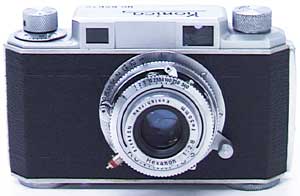


While Konica I was started to be manufactured in 1947 based on "Rubicon" that had been designed and produced experimentally during 1938-1940, it was first introduced on the market in 1948 by an order of G.H.Q occupying in Japan at the price of 19,700 yen (a several times as expensive as a monthly income of a general office worker).
In 1950, "Konirapid", shutter unit build in Konica I, was changed to Konirapid S which integrated flash sync contact, and also the lens was improved from Hexar 50mm f/3.5 to f2.8. And year after that, new half-mirror developed by Roku Konishi (who was also a founder of Konica) was adopted on the camera, which made focusing control much easier, and at the same time Hexanon 50mm f/2.8 was employed on it.
In those days, a book named "a guide to Konica" published by Amiko publisihng company was selling well to not only those who had already got the camera, but also planned or wanted to buy one, which effected a sale for the camera itself at the same time. And afterwards in ten years, Konica I, II and III sold over 500,000.*Rubicon : The 35mm lens-shutter camera designed before the war. This was put on the shelf due to the war had been in a severe situation in Japan and the production of cameras to the public wasn't allowed.
Rubicon was named after the line "cross the Rubicon" by Ceasar. And as the way it is, it had to be renamed after the war.
Konica I succeeded almost all - appearance design, spcification and function - to Rubicon.Well then, let's take a look at it.
- Picture size : 24 x 36mm
- Lens : Hexanon 50mm f/2.8 (collapsible barrel type)
- Shutter : Konirapid S
- Shutter speeds :
- B, 1, 1/2, 1/5, 1/10, 1/25, 1/50, 1/100, 1/250, 1/500 sec.
- (T is added on the "made in occupied Japan" model.)
- Focusing : helicoid focusing
- Closest focusing distance : 3.3 ft.
- Film transport : depressing the wind releasing button first, and turn the wind knob on the camera top.
- Frame counter : forward-counting counter
|
| Back to Camera Shopper | Back to Index Page |